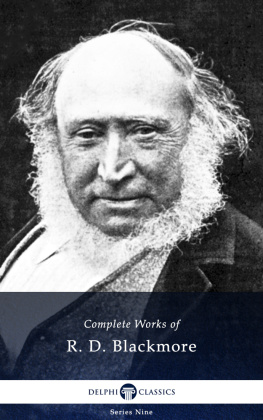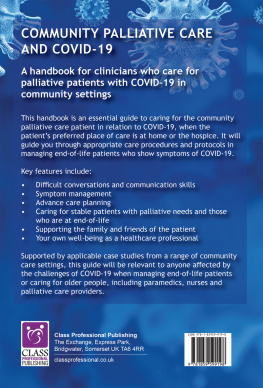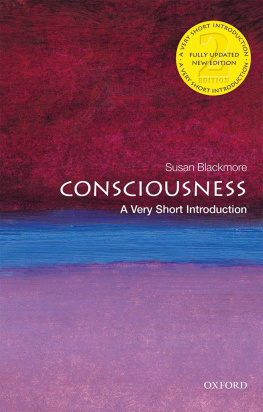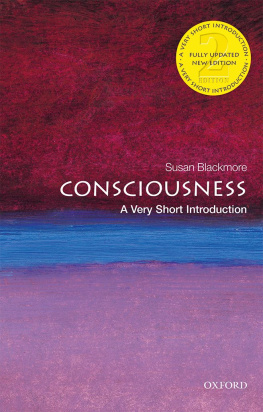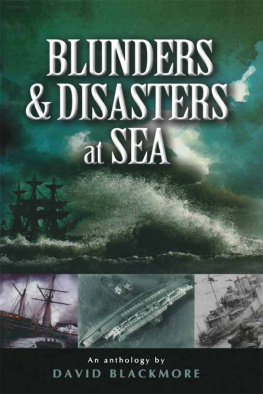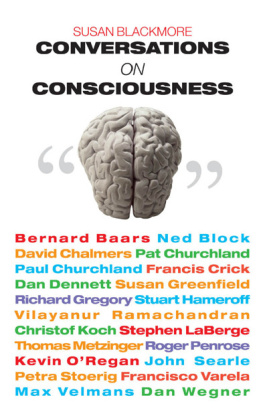Susan J. Blackmore - Seeing myself : the science of out-of-body experiences
Here you can read online Susan J. Blackmore - Seeing myself : the science of out-of-body experiences full text of the book (entire story) in english for free. Download pdf and epub, get meaning, cover and reviews about this ebook. year: 2017, publisher: Little, Brown Book Group, genre: Religion. Description of the work, (preface) as well as reviews are available. Best literature library LitArk.com created for fans of good reading and offers a wide selection of genres:
Romance novel
Science fiction
Adventure
Detective
Science
History
Home and family
Prose
Art
Politics
Computer
Non-fiction
Religion
Business
Children
Humor
Choose a favorite category and find really read worthwhile books. Enjoy immersion in the world of imagination, feel the emotions of the characters or learn something new for yourself, make an fascinating discovery.
- Book:Seeing myself : the science of out-of-body experiences
- Author:
- Publisher:Little, Brown Book Group
- Genre:
- Year:2017
- Rating:5 / 5
- Favourites:Add to favourites
- Your mark:
- 100
- 1
- 2
- 3
- 4
- 5
Seeing myself : the science of out-of-body experiences: summary, description and annotation
We offer to read an annotation, description, summary or preface (depends on what the author of the book "Seeing myself : the science of out-of-body experiences" wrote himself). If you haven't found the necessary information about the book — write in the comments, we will try to find it.
Seeing myself : the science of out-of-body experiences — read online for free the complete book (whole text) full work
Below is the text of the book, divided by pages. System saving the place of the last page read, allows you to conveniently read the book "Seeing myself : the science of out-of-body experiences" online for free, without having to search again every time where you left off. Put a bookmark, and you can go to the page where you finished reading at any time.
Font size:
Interval:
Bookmark:
Susan J. Blackmore is a distinguished and influential psychologist, known for her books exploring consciousness, memetics, evolution and spirituality. Her first book Beyond the Body (1982) was hailed as a classic and the life-changing experience detailed in that book is revisited and explained in Seeing Myself. Susan is a Visiting Professor at The University of Plymouth but now mainly works freelance, giving lectures all over the world both at academic conferences and to the public.
By the same author
Zen and the Art of Consciousness, 2011 Oneworld
Consciousness: An Introduction, Second Edition, 2010 Hodder Education
Conversations on Consciousness, 2005 Oxford University Press
A Very Short Introduction to Consciousness, 2005 Oxford University Press
The Meme Machine, 1999 Oxford University Press
With Adam Hart-Davis, Test Your Psychic Powers, 1995 Thorsons
In Search of the Light: The Adventures of a Parapsychologist, 1996 Prometheus
Dying to Live: Science and the Near Death Experience, 1993 Grafton
Beyond the Body: An investigation of out-of-the-body experiences, 1982 Heinemann
What Out-of-body Experiences Tell Us About Life, Death and the Mind
Susan J. Blackmore

ROBINSON
First published in Great Britain in 2017 by Robinson
Copyright Susan J. Blackmore, 2017
The moral right of the author has been asserted.
All rights reserved.
No part of this publication may be reproduced, stored in a retrieval system, or transmitted, in any form, or by any means, without the prior permission in writing of the publisher, nor be otherwise circulated in any form of binding or cover other than that in which it is published and without a similar condition including this condition being imposed on the subsequent purchaser.
A CIP catalogue record for this book is available from the British Library.
Every effort has been made to trace the copyright holders and to obtain their permission for the use of copyright material. The publisher apologizes for any errors or omissions and would be grateful if notified of any corrections that should be incorporated in future reprints or editions of this book.
ISBN: 978-1-4721-3738-8
Robinson
An imprint of
Little, Brown Book Group
Carmelite House
50 Victoria Embankment
London EC4Y 0DZ
An Hachette UK Company
www.hachette.co.uk
www.littlebrown.co.uk
To everyone who has had an out-of-body experience and not known what to make of it.
I have chosen to use an academic referencing system for this book. The way it works is that I put the authors name and year for each book or article I am writing about in parentheses. Then all the publications are listed in alphabetical order at the end of the book. By convention, a maximum of two authors are given in the text. If an article has more than two I insert et al which, in Latin, means and others. All authors are shown in the list at the end unless there is a really huge number. The system I am using is the APA; American Psychological Association system. Following the main reference list is a list of websites that I have quoted from.
I am doing this because I hope the book may be useful to other OBE researchers in the future. When I read any science book I want to see immediately which research is being referred to. Sometimes, from the author and date, I know already and this helps me assess whether the discussion of it is correct. Sometimes I recognise the authors but dont know this particular paper. And sometimes I know that the work is new to me and I must look it up. Only then do I have to turn to the list at the back.
Many popular science books use end notes. Personally this drives me up the wall. I do not want to keep interrupting my reading to look at a confusing list at the back, especially when the notes are presented by chapter and Ive forgotten which chapter I am currently reading! The other is that I sometimes want to check whether the book includes a given piece of research and for that I need an alphabetical list, not one listed by order of appearance in the book.
If you are not familiar with this system I hope that once youve been reading for a while youll get used to skipping straight over the names in parentheses and that this full referencing system will be helpful.
I could not have completed this book without the help of many friends and colleagues who have sent me images or copies of their work, explained difficult procedures or analyses, and answered my persistent questions. I would especially like to thank Carlos Alvarado, Jason Braithwaite and Ken Ring for their generous help, and my son, Jolyon Troscianko, for his delightful cartoons of the aura test and the rubber hand illusion. Thanks too to my agent, Donald Winchester, who has provided steady help and reassurance throughout. My husband, Adam Hart-Davis, has put up with me during my obsession with trying to understand the OBE, as well as helping in practical ways including acting as my editor, reading the entire book and providing invaluable suggestions. My thanks to you all.
I was just nineteen when everything I thought I knew was overthrown and my life changed direction. If I had imagined a future in some sensible university job, that was now impossible for I was determined to understand what had happened to me. For just a couple of hours I was no longer confined to a slow, heavy, physical body but escaped through a tunnel into a world of flying, exploring the world from outside my body and finally entering the mystical experience of oneness, of unity with the universe.
How could an enthusiastic first-year student of psychology understand any of this? I couldnt. There was nothing in the narrow 1960s science we were learning at Oxford that had any bearing on such adventures. Indeed, our lecturers made it quite clear that we were not there to think about (or even mention) such woolly topics as the nature of mind or the meaning of consciousness, but to study measurable behaviour and only measurable behaviour. I had never heard of tunnel experiences, and the phrase near-death experience (NDE) had not yet been invented. So I jumped to my own conclusions. I was sure that my spirit had left my body and would survive after death. I was convinced that telepathy and clairvoyance must be possible and that ghosts were real. From that day on I became determined to devote my life to parapsychology and to prove all my closed-minded lecturers wrong.
I failed; of course I failed. The conclusions I had jumped to so quickly were ill-thought-out and superficial. But never mind. The vivid memories of those few hours kept driving me on. Nearly half a century later I can look back and see the way my intellectual life has been shaped, pushed and pulled by the experience, and how my spiritual life might never have even begun had I not found myself disappearing into selflessness without having a clue what that was.
So that failure has shaped the story of my life. I did become a parapsychologist, hunting for paranormal phenomena and failing, time and again, to find them (Blackmore, 1996). That repeated failure, over months and years of experimentation, drove me back again and again to my own experience, the memory of which I could never shake off, but nor could I induce it to happen again. At first, I tried to understand it by studying the occult, sitting with mediums, learning to read Tarot cards and training as a witch. I still have my beautiful crystal ball that I learned to peer into. I studied mystical theories of spirit separation and astral projection and found they led only to confusion and wild, untestable conjectures.
Next pageFont size:
Interval:
Bookmark:
Similar books «Seeing myself : the science of out-of-body experiences»
Look at similar books to Seeing myself : the science of out-of-body experiences. We have selected literature similar in name and meaning in the hope of providing readers with more options to find new, interesting, not yet read works.
Discussion, reviews of the book Seeing myself : the science of out-of-body experiences and just readers' own opinions. Leave your comments, write what you think about the work, its meaning or the main characters. Specify what exactly you liked and what you didn't like, and why you think so.



